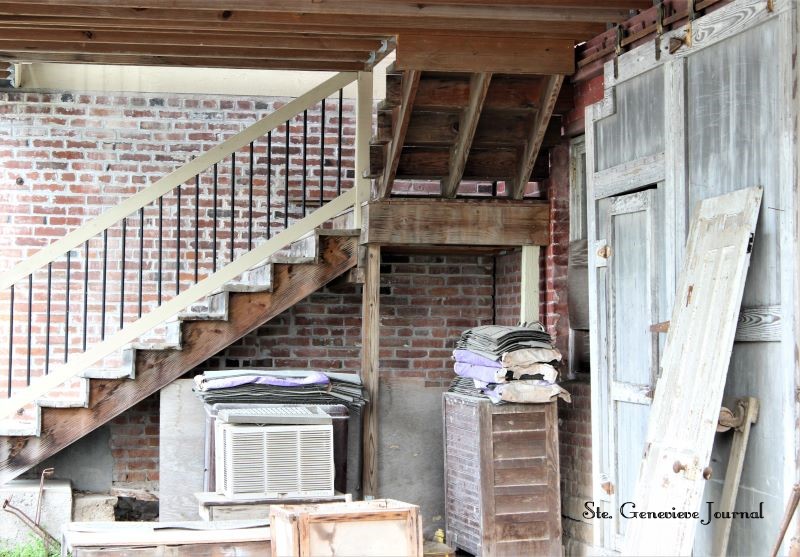From: The French 500
Introduction to 1790 Passenger Lists
by Henny Evans
by Henny Evans
"In October, 1790 Gallipolis, Ohio was settled by a group of French who later became known as the French Five Hundred. The settlers sailed on several ships to several ports, the main one being Alexandria,Virginia, on their way to the final destination of Gallipolis, the City of the Gauls. At that time Gallipolis was pure wilderness and the French, primarily artisans and craftsmen, were totally unprepared for what they would find…100 cabins in what is now the City Park with lookouts on each corner. Many of the Frenchmen were fleeing the French Revolution and seeking refuge in America.
When they arrived in Gallipolis, they were faced with the fact that they did not own land in Gallipolis at all. The Scioto Company which had collected some monies from the French had never purchased the land from the Ohio Company, so when the settlers arrived their deeds were worthless. It was five more years before Pres. Washington stepped in and granted them free land in the French Grant which was not even in Gallia County, but in Scioto County. However, at that time Ohio was not a state but part of the Northwest Territory and boundaries for Gallia County did not exist. Those moving to the French Grant had to live on the land for five years in order to own it. Those staying in Gallipolis had to purchase land a second time, this time from the rightful owners, the Ohio Company.
There have been several sources naming the various ships that carried the French to America. However, about 1993 it was discovered that all of these names were not accurate. Jocelyne Zanelli of Baule, France who was working on her thesis about Gallipolis came for a visit. (Reference to the book that resulted from her thesis is in the next paragraph.) One of the things she shared with me was two passenger lists which have now been posted on the website. These lists are of the Liberty and the Patriot. Ships that we know are accurate include the Recovery, an English ship with 86 passengers, which was damaged in crossing and the passengers rescued by another British ship, the Elizabeth; the Liberty, a French ship with 121 passengers; the Patriot, a French ship with 150 passengers; the Nautilus of Scarborough, an English ship with 119 passengers, thirty of whom were aristocrats and the rest were laborers; the Discovery, Lady Washington, Union, Citizens of Paris and Mary.
Much more detail is given in the book written by Jocelyne. (It is written in French.) Please refer to Jocelyn Moreau-Zanelli’s book published in 1996 by L’Harmattan, "Gallipolis: histoirie d'un mirage americain au XVIIIe siecle."
When using the lists we found the name of the traveler, a profession, gender, birthplace and age. Also, you could tell the group in which a person traveled. We did use a French to English dictionary for the professions and even then it was not always clear. We added question marks or simply left it in French with quotes around it if we could not decipher it. The variety of occupations would have allowed for a town to have been created. These included wholesalers, woodcutters, clock makers, doctors, lawyers, farmhands, tailors, wig makers and so on.
There is no guarantee that those who were on the passenger lists actually came to Gallipolis but we know that many did as their names appear somewhere in our history."
Connection to New Bourbon, New Madrid, and Possibly Ste. Genevieve(short version)
In the autumn of 1790, Pierre-Charles de Hault de Lassus de Luzieres, an aristrocrat sought shelter and fortune in America due to the French Revolution, brought his family and goods aboard the Citizens of Paris ship. He had purchased 2000 arpents in Ohio from the Scioto Company in Paris. When he finally arrived at Gallipolis, he learned that he did not own any land of any sort. He and his family went to Pittsburgh, bought land there for a plantation and started building a house worthy of it. Being an aristocrat, Pierre desired a place in politics and began eyeing Spanish Louisiana as a cause worthy to look into. He had grown up with the Governor of that territory, Baron de Carondolet, and felt he would have no problem securing land and furthering his political stance.
Arms of Pierre de Lassus
With his new partners Bartholeme Tardiveau and Pierre Audrain, Pierre de Lassus headed for New Orleans with a plan for helping to populate Colonial Spain, as well as to build two mills and bakeries.
"John B. C. Lucas, who was born in Normandy, France, commented, "I learn that Mr. Tardevaux has gone down to New Orleans with Audrain and Luzeries." (Western Pennsylvania Historical Magazine Vol 21, p 221 & 222)[Chevalier Pierre Charles de Hault de Lassus de Luzieres, who later settled at Nouvelle Bourbon, Upper Louisiana, and whose son was the last Spanish governor of the district]. He was engaged with Tardiveau and Audrain in a scheme to remove a considerable number of Gallipolis colonists to a new location in Upper Louisiana. All three were in New Orleans in April 1793. Andre Micheaux was in Pittsburgh from July 27 until 14 August 1793, and who wrote in his journal (p 31) "A Frenchman who has resided in America for fourteen years and whose business consists in shipping supplies of flour to New Orleans told me that he would give me Letters for Illinois addressed to the Commandant of the Post of St. Louis. He is at present settled in Pittsburgh and his name is Pierre Audrain. This Audrain is said to be in partnership with one Delousiere who was exiled from France for having been concerned in a plot to deliver Havre to combined English and Spanish fleets. This Louisiere is at present absent from Pittsburgh." Audrain had left New Orleans late in April to go back East to collect his colonists." Western Pennsylvania Historical Magazine, Vol. 11 p 122, notes that the Peter Audrain's home is located at Smithfield and Cherry Streets on a 1795 map of Pittsburgh."
 |
| BARON DE CARONDOLET |
By 1793, Pierre de Lassus had established New Bourbon on a high bluff overlooking Le Grand Champ by order of Baron de Carondelet. He was appointed the first civil and military commandant when he arrived there in August, 1793. Due to a scandalous accusation that de Lessus had received personal compensation for the relocation of the inhabitants of Gallipolis to New Bourbon, only a few aristocrats made the move. One was Jean Rene Guiho, lord of Klegand, a native of Nantes, Brittany. He was invited by de Lassus to take up his residence in the village, and was given a grant of 500 arpents on the Saline river.
De Lassus did have ties at the time to New Madrid, for it was in New Madrid and Ste. Genevieve that grist mills were to be built for Colonial Spain, as ordered by Governor Carondolet. Tardiveau was to oversee the mill in New Madrid and de Lussus the one in Ste. Genevieve.
 |
| 18th CENTURY COLONIAL FRENCH |
There were several from Gallipolis who did move to the New Madrid area, one of whom was Francois Gervais. In April 1793, Carondolet listed him as a principle French emigrant still residing at Gallipolis, on the shores of the Ohio. He stated that Gervais was an excellent farmer with a fortune. There was an additional note that Gervais later settled in New Madrid. Francois Gervais' initial Spanish land grant was for 730 arpents (649 acres awarded in 1804) in the Little Prairie settlement south of New Madrid, close to John Ruddle, my ancestral grandfather. In 1805(8), Francois had accumulated more land and had married my 4th great aunt, Frances or "Fanny" Ruddle, daughter of John.
Also from Gallipolis was Jean Gabriel Gervais, a lawyer reported to "cut a fine figure as he strode about town, twirling his silver-headed cane, paying delicate compliments to the ladies, and regaling the men with a ready fund of worldly stories."
Another person of nobility settling in New Madrid was Francois LaForge, an aristocrat who had sailed on the Patriot from Le Havre, France on the 19 February 1790. He had been educated to become a priest but fell in love with his cousin Margaret Champagne and married her instead. The family lived in Paris but left during the French Revolution for Gallipolis, Ohio. There they lived until 1794 when they removed to the New Madrid District in Spanish Louisiana (Missouri). He was held in high esteem by the authorities, including Charles de Lassus, son of Pierre de Lassus. He was appointed interpreter and public writer, an adjutant of the militia, justice of the peace and notary public.
Nicolas Augar, a native of France, settled first in Gallipolis then moved to New Madrid. He married a daughter of George Ruddell, nephew of John, who also lived in the district.
Luis Vandenbenden, a civil engineer, came to New Madrid to help build one of two grist mills ordered by Governor de Carondolet. He brought his brother, Joseph, who was intended to manage the bakery to be established by Audrain, Tardiveau and Co. at New Madrid, once the mill was built.
As a side note, Bartholeme Tardeveau, one of de Lassus' partners, was not from Gallipolis but did reside in New Madrid to oversee the establishment of the mill. Pierre was to oversee the building of the Ste. Genevieve mill.
It is possible that a few persons from Gallipolis may have settled in Ste. Genevieve also. I have included the lists here in hopes that it may help genealogists find more clues to their French heritage. I did note a Menard name but don't know if there is any connection to the local Menards of Kaskaskia and Ste. Genevieve. There was also a Menard family who settled in New Madrid.
I find it interesting that very few sailing on the Patriot and the Liberty were farm workers or commoners other than the servants most of the nobility brought with them. Untamed Ohio must have been a shock to those of the aristocracy who were not prepared for the harshness of the frontier.
(Use Zoom on Your Computer to Enlarge
or View at: THE FRENCH 500 )
 |
| THE PATRIOT |
 | ||
| THE LIBERTY |





































